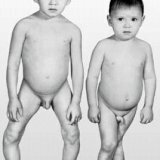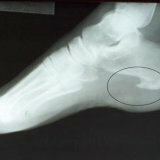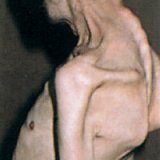Dislocation of the lower jaw: symptoms, treatment, ways of correction

The dislocation of the jaw is a pathological condition in which the head of the lower jaw comes out of its anatomical position - the joint fossa of the temporal bone.Such a nuisance can happen to anyone.The dislocation of the jaw can easily be obtained only during chewing or even yawning.What to do, if such a nuisance still occurred, to which doctor should I apply?
Table of Contents: Structure of the lower jawThe mandibular jaw is represented by a fixed upper and moving lower jaw, temporomandibular joint, chewing muscles.The lower jaw is attached to the skull due to the temporomandibular joint( TMJ).Normally the head of the lower jaw is located in the joint fossa of the temporal bone.The jaw joint is very mobile and sliding.Under the influence of an unfavorable factor, the head of the lower jaw jumps out of the joint fossa of the temporal bone, so a dislocation of the jaw is formed.

Reasons for dislocation
The lower jaw is held in the anatomical position by the ligament apparatus.In order for its displacement to occur, it is necessary to apply a force that would exceed the capabilities of the ligaments themselves.
The most common causes of dislocation are:- Jaw injuries( due to impact, fall);
- Excessive mouth opening when yawning, chewing food, singing and even laughing;
- Opening bottles, chopping nuts with teeth;
- Diseases of the joint( arthritis, gout, rheumatism).
It is worth noting that more often jaw dislocations are recorded in women.This is due to anatomical features: the joint fossa of the temporal bone in women is smaller, and the ligamentous apparatus is less durable.
Types of dislocation
 There are various classifications of dislocations of the mandible.So, one-sided and bilateral dislocations are distinguished.With a unilateral dislocation, the jaw head moves from one side: the right or the left.In bilateral - both temporomandibular joints are displaced.
There are various classifications of dislocations of the mandible.So, one-sided and bilateral dislocations are distinguished.With a unilateral dislocation, the jaw head moves from one side: the right or the left.In bilateral - both temporomandibular joints are displaced.
Also distinguish between anterior and posterior dislocations.The difference is that with anterior dislocations the head of the lower jaw is displaced anteriorly in relation to the joint fossa of the temporal bone, and with rear dislocations it is rearward.
If there is a complete discrepancy between the articular surfaces of the head of the lower jaw and the fossa of the temporal bone - they speak of complete dislocation.If partial mismatch of articular surfaces - talk about subluxation.
For the duration of existence, distinguish primary, chronic( there are more than a week) and habitual( often recurrent) dislocations.
The dislocation of the lower jaw can be uncomplicated and complicated.Complications are dislocations of a jaw fracture, rupture of muscles, ligaments, vessels and nerves.
Symptoms of dislocation of the lower jaw
The clinical picture of the disease will depend on the type of dislocation.Always at the time of a dislocation, there is a characteristic click in the temporomandibular joint and sudden pain.With anterior dislocation, the jaw hangs down and is pushed somewhat forward.Despite attempts to close his mouth, it is not possible for a person to do it on his own.Because of difficulty swallowing, saliva accumulates excessively in the mouth, salivation is observed.If a dislocated unilateral face looks asymmetrical, skewed.Speech is difficult, often a person can not speak at all.
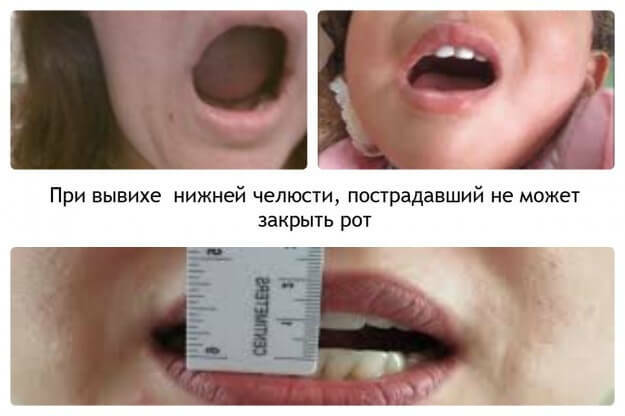
With posterior dislocation, the jaw is shifted backward relative to the upper jaw.Posterior dislocation is dangerous for a potentially possible fracture of the bone wall of the auditory canal.
The habitual dislocations arise from primary or chronic, against the background of pronounced overstretch of ligaments and capsule of the joint, which leads to loss of joint stability.In this case, even minor movements of the jaw lead to the slipping of the head of the lower jaw from the joint fossa.
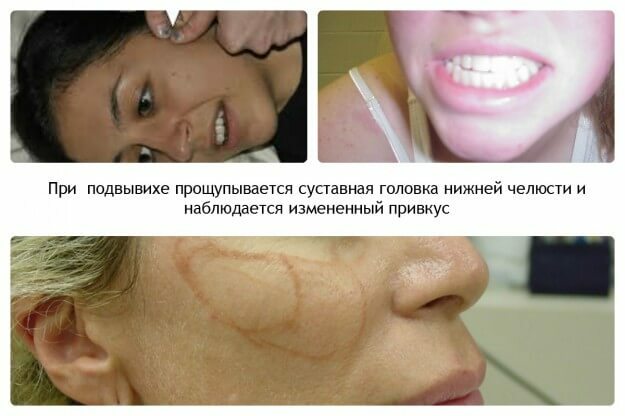
Treatment of dislocation of the lower jaw
Where to go if a dislocation of the lower jaw occurs?With this problem you need to go to the emergency department.Treatment is either conservative or surgical.In most cases, traumatologists prefer the conservative method of treatment, but when it turns out to be ineffective or impossible to resort to surgery.
The essence of conservative treatment is to direct the displaced head of the jaw back into the joint fossa.There are several techniques for correcting the dislocation of the jaw, one of the most popular methods is the method of Hippocrates.
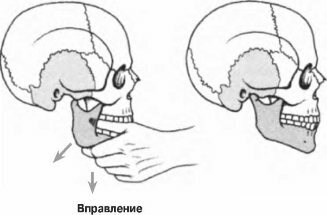
The patient is seated in a chair with a head restraint, the body and head should be pressed against the chair.Then proceed to anesthesia.This can be both local anesthesia and anesthesia.Often dislocations and completely without the use of anesthesia.
The doctor wraps his thumbs around with a towel or bandage and places them on the back molars of the lower jaw, with the other fingers wrapping the lower jaw from the outside.The fingers must be wrapped in a cloth to prevent them from being injured while refitting.
 Smoothly moving the doctor presses the jaw down, then back and up.When the correction occurs a characteristic click, and the jaw closes.At this point, the doctor needs to have time to remove the fingers from his mouth.After correcting the dislocation, the joint should be fixed for two weeks with the help of bandage-sling dressings or a tire.
Smoothly moving the doctor presses the jaw down, then back and up.When the correction occurs a characteristic click, and the jaw closes.At this point, the doctor needs to have time to remove the fingers from his mouth.After correcting the dislocation, the joint should be fixed for two weeks with the help of bandage-sling dressings or a tire.
Surgical treatment is used in case of old and habitual dislocations, when conservative treatment is not sufficiently effective.The essence of the operation is to strengthen the ligaments, which can fully hold the temporomandibular joint in the joint fossa.During the operation, the dislocation is inserted and the joint disc is securely fixed.
Also to surgical treatment resorted to in case of complicated dislocation.The purpose of the operation in this case is not only to correct the dislocation, but also to eliminate complications( stitching of damaged vessels, nerves, etc.).
In case of a jaw dislocation it is necessary to go to the hospital, referral and further treatment is carried out only by medical personnel.Before entering the hospital, the patient needs first aid: fix the jaw with a handkerchief, apply ice to the temporomandibular joint.
Grigorova Valeria, medical reviewer

